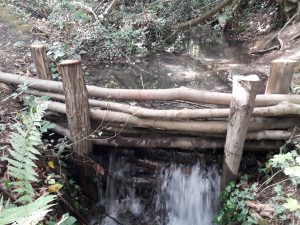Salmons Brook: Harnessing nature to cut flood risk in Enfield
Many areas in Enfield, north London, have suffered severe flooding in the recent past. The £15.3 million Salmons Brook Flood Alleviation Scheme was completed in 2016, reducing the risk to more than 2,500 homes. However, some areas still remain at risk.
The Salmons Brook Natural Flood Management project
The Salmons Brook NFM pilot project aims to slow the flow and store water higher in the rural areas of the Salmons Brook catchment in north Enfield, especially in and after periods of heavy rainfall. It aims to demonstrate the costs, benefits and lessons learnt of carrying out NFM in the urban fringe, to help inform best practice nationally.

A leaky dam: one example of natural flood management

The Salmons Brook Catchment
The upper reaches of the Salmons Brook catchment sit within London’s greenbelt, north of Enfield Road, encompassing Trent Park and a large amount of agricultural and park land. This includes two streams connected to the Salmons Brook: the Merryhills Brook and the Leeging Beech Gutter.
We are collaborating with land owners, farmers, Friends of Groups, and other interested parties to help plan and install NFM interventions. These include parcels of tree planting, pond creation, and a land use management review.
The initial phase ran between 2017 and 2021, funded by DEFRA, as a partnership between Enfield Council, the Environment Agency and Thames21. Additional funding provided by the Thames Regional Flood and Coastal Committee (TRFCC) has allowed the project to expand to cover a larger area and run until July 2022.
The inital phase has successfully complemented existing flood defences and helped protect 20 more properties in Enfield. Our longer term vision for the Salmons Brook project is that the scheme will help protect hundreds more homes from flooding, help improve the health of the river by regulating flows, stabilising the soils on the land and enhancing the value of the green space for wildlife and people.
The key findings of the initial phase are:
- Leaky dams, one of the NFM installaions, boosted biodiversity by creatingv a variety of in-channel habitats.
- Silt and organic matter was held back by the leaky dams which then protected areas of gravel downstream, which provide habitat for invertebrates. In turn, these provide food for other species to feed on.
- Areas of woodland were inundated with water for longer periods, allowing a variety of plants to colonise certain areas.
Recommendations:
- Local community engagement is a crucial component to the success of this kind of project.
- Projects like this benefit highly from initial stakeholder and community consultation to validate any hydrological models.
- Leaky dams need to be created in a range of sizes to perform different functions: storing water, spreading water across the landscape, holding sediment and slowing the flow of water.
- Ecology surveys are useful to indicate sensitive areas, especially within sites of special scientific interest (SSSIs).
For more information about the project please refer to the full report “Salmons Brook Natural Flood Management Pilot: Results and Lessons.”
To discuss the project or NFM at Thames21 please contact Stephen Haywood.
